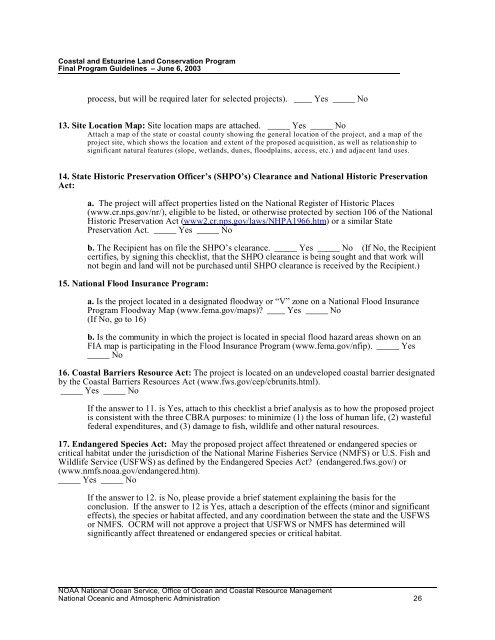Honu'apo Park Resource Management Plan
Honu'apo Park Resource Management Plan
Honu'apo Park Resource Management Plan
Create successful ePaper yourself
Turn your PDF publications into a flip-book with our unique Google optimized e-Paper software.
Coastal and Estuarine Land Conservation Program<br />
Final Program Guidelines – June 6, 2003<br />
process, but will be required later for selected projects). ____ Yes _____ No<br />
13. Site Location Map: Site location maps are attached. _____ Yes _____ No<br />
Attach a map of the state or coastal county showing the general location of the project, and a map of the<br />
project site, which shows the location and extent of the proposed acquisition, as well as relationship to<br />
significant natural features (slope, wetlands, dunes, floodplains, access, etc.) and adjacent land uses.<br />
14. State Historic Preservation Officer’s (SHPO’s) Clearance and National Historic Preservation<br />
Act:<br />
a. The project will affect properties listed on the National Register of Historic Places<br />
(www.cr.nps.gov/nr/), eligible to be listed, or otherwise protected by section 106 of the National<br />
Historic Preservation Act (www2.cr.nps.gov/laws/NHPA1966.htm) or a similar State<br />
Preservation Act. _____ Yes _____ No<br />
b. The Recipient has on file the SHPO’s clearance. _____ Yes _____ No (If No, the Recipient<br />
certifies, by signing this checklist, that the SHPO clearance is being sought and that work will<br />
not begin and land will not be purchased until SHPO clearance is received by the Recipient.)<br />
15. National Flood Insurance Program:<br />
a. Is the project located in a designated floodway or “V” zone on a National Flood Insurance<br />
Program Floodway Map (www.fema.gov/maps)? ____ Yes _____ No<br />
(If No, go to 16)<br />
b. Is the community in which the project is located in special flood hazard areas shown on an<br />
FIA map is participating in the Flood Insurance Program (www.fema.gov/nfip). _____ Yes<br />
_____ No<br />
16. Coastal Barriers <strong>Resource</strong> Act: The project is located on an undeveloped coastal barrier designated<br />
by the Coastal Barriers <strong>Resource</strong>s Act (www.fws.gov/cep/cbrunits.html).<br />
_____ Yes _____ No<br />
If the answer to 11. is Yes, attach to this checklist a brief analysis as to how the proposed project<br />
is consistent with the three CBRA purposes: to minimize (1) the loss of human life, (2) wasteful<br />
federal expenditures, and (3) damage to fish, wildlife and other natural resources.<br />
17. Endangered Species Act: May the proposed project affect threatened or endangered species or<br />
critical habitat under the jurisdiction of the National Marine Fisheries Service (NMFS) or U.S. Fish and<br />
Wildlife Service (USFWS) as defined by the Endangered Species Act? (endangered.fws.gov/) or<br />
(www.nmfs.noaa.gov/endangered.htm).<br />
_____ Yes _____ No<br />
If the answer to 12. is No, please provide a brief statement explaining the basis for the<br />
conclusion. If the answer to 12 is Yes, attach a description of the effects (minor and significant<br />
effects), the species or habitat affected, and any coordination between the state and the USFWS<br />
or NMFS. OCRM will not approve a project that USFWS or NMFS has determined will<br />
significantly affect threatened or endangered species or critical habitat.<br />
NOAA National Ocean Service, Office of Ocean and Coastal <strong>Resource</strong> <strong>Management</strong><br />
National Oceanic and Atmospheric Administration 26


